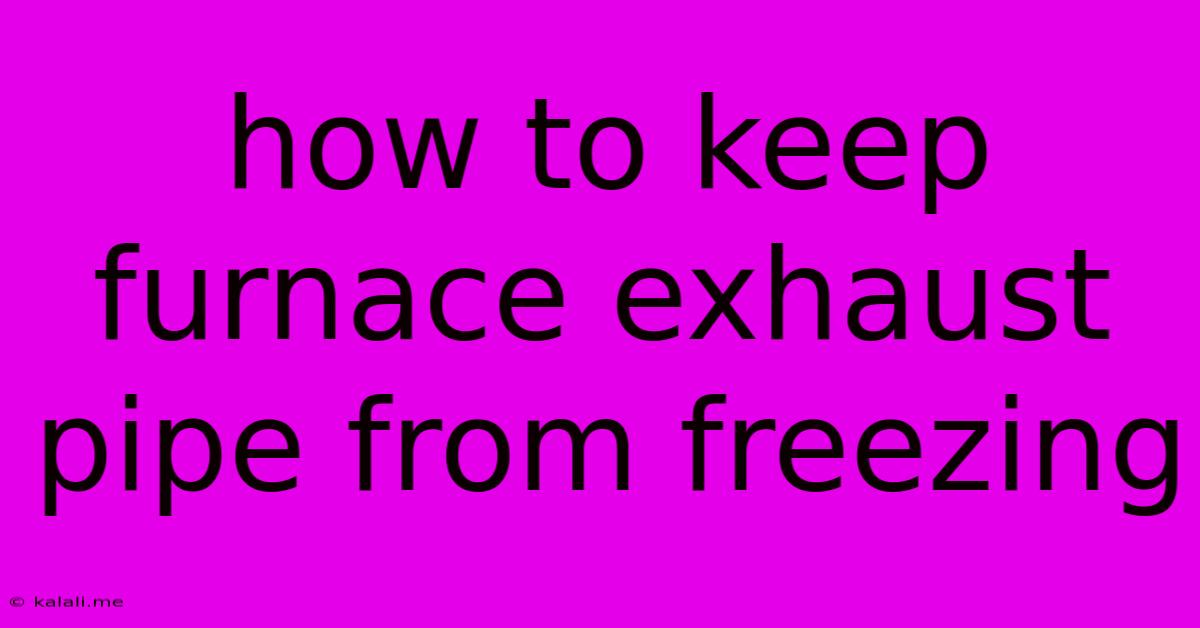How To Keep Furnace Exhaust Pipe From Freezing
Kalali
Jun 02, 2025 · 3 min read

Table of Contents
How to Keep Your Furnace Exhaust Pipe From Freezing: A Comprehensive Guide
Winter's icy grip can wreak havoc on your home's heating system, and a frozen furnace exhaust pipe is a common and potentially dangerous problem. A blocked exhaust pipe prevents your furnace from venting combustion byproducts safely, leading to carbon monoxide buildup – a serious health risk. This guide provides practical solutions to prevent this frustrating and hazardous issue. Understanding the causes and implementing preventative measures will ensure your family's safety and keep your furnace running smoothly all winter long.
Understanding the Problem: Why Furnace Exhaust Pipes Freeze
Frozen furnace exhaust pipes are primarily caused by condensation. Your furnace burns fuel, producing water vapor as a byproduct of combustion. This moisture, when coupled with cold outside temperatures, condenses within the exhaust pipe. If the temperature drops low enough, this condensation freezes, creating an ice blockage. Several factors contribute to this problem:
- High Humidity Levels: High indoor humidity increases the amount of water vapor your furnace produces.
- Short Exhaust Pipe: Shorter pipes have less time to warm the escaping gases before they reach the colder exterior, increasing condensation.
- Poor Ventilation: Inadequate ventilation can lead to higher humidity levels within your home.
- Inadequate Insulation: Lack of proper insulation around the exhaust pipe allows heat to escape rapidly, accelerating condensation and freezing.
- Cracks or Gaps in the Pipe: Leaks in the exhaust pipe allow cold air to enter, further cooling the exhaust gases and promoting condensation.
Effective Solutions to Prevent Frozen Exhaust Pipes
Preventing a frozen furnace exhaust pipe involves a multi-pronged approach, focusing on reducing condensation and keeping the pipe warm. Here are some proven strategies:
1. Improve Ventilation: Ensure your home has adequate ventilation to reduce indoor humidity. Open windows periodically (weather permitting) or use exhaust fans in bathrooms and kitchens. Consider installing a whole-house ventilation system for optimal air circulation.
2. Insulate the Exhaust Pipe: Properly insulating the exhaust pipe is crucial. Use high-quality insulation designed for exhaust pipes, specifically rated for high temperatures. Ensure the insulation is securely attached to prevent gaps and heat loss.
3. Install a Condensation Trap: A condensation trap is a device installed in the exhaust pipe that collects and drains condensed water, preventing it from freezing. These traps are particularly effective in areas with high humidity and frequent temperature fluctuations.
4. Use a Furnace Exhaust Pipe Heater: These electric heaters are designed to wrap around the exhaust pipe, providing supplemental heat to prevent ice formation. They are particularly helpful in extremely cold climates or for homes with particularly long exhaust pipes.
5. Maintain Proper Furnace Maintenance: Regular furnace maintenance by a qualified technician is essential. This includes inspecting the exhaust system for cracks, leaks, or blockages, ensuring the venting system is functioning correctly, and cleaning the system to prevent buildup that could impede airflow.
6. Check for Cracks and Leaks: Regularly inspect the exhaust pipe for any cracks or leaks. Small gaps can allow cold air to enter, increasing the likelihood of freezing. Repair any damage promptly to prevent further problems.
Recognizing the Signs of a Frozen Exhaust Pipe
Early detection is key to preventing a complete blockage and potential safety hazards. Be vigilant for these warning signs:
- Furnace Cycling On and Off Frequently: A frozen exhaust pipe can cause the furnace to shut down due to safety mechanisms.
- Unusual Noises: Unusual noises coming from the furnace or exhaust system could indicate a blockage.
- Decreased Heating Efficiency: Noticeably less heat in your home could signal a problem with the exhaust system.
- Smell of Gas: A noticeable gas odor is a serious warning sign and demands immediate professional attention.
Conclusion: Prioritize Safety and Preventative Measures
Preventing a frozen furnace exhaust pipe is critical for ensuring the safe and efficient operation of your heating system. By proactively addressing the potential causes and implementing the preventative measures outlined in this guide, you can enjoy a warm, comfortable, and safe winter. Remember, if you suspect a problem with your furnace exhaust system, contact a qualified HVAC technician immediately. Never attempt repairs yourself if you lack the necessary expertise.
Latest Posts
Latest Posts
-
How To Keep A Door From Closing
Jun 04, 2025
-
Ac Blower Fan Not Working In Auto Mode
Jun 04, 2025
-
Should I Show May As Being Abbreviated
Jun 04, 2025
-
Smoke Coming Out Of A C Vents In Car
Jun 04, 2025
-
Can Microsoft Flight Simulator Teach You To Fly
Jun 04, 2025
Related Post
Thank you for visiting our website which covers about How To Keep Furnace Exhaust Pipe From Freezing . We hope the information provided has been useful to you. Feel free to contact us if you have any questions or need further assistance. See you next time and don't miss to bookmark.